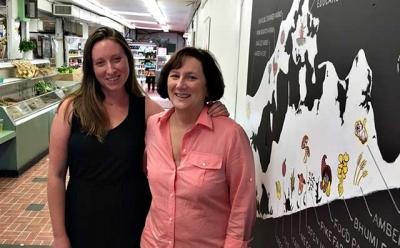New Take on an Old Favorite
New Take on an Old Favorite

Customers expecting overflowing bins of fresh produce or deli cases bursting with prepared foods might be confused upon entering the new Amagansett Farmers Market, which the Amagansett Food Institute reopened on Aug. 1. The selection is small compared to what was offered by previous proprietors. Take a closer look, though, and you’ll notice that almost everything in the market, save the olive oil, is grown or produced on Long Island or in New York State, some of it at the institute’s own business-incubator kitchen at Stony Brook Southampton, called South Fork Kitchens.
There’s ice cream by the scoop from Joe and Liza’s Ice Cream in Sag Harbor, a Lucy’s Whey concession with a focus on cheeses produced in New York State, frozen Gula Gula Empanadas made in Mattituck, Plain T iced tea by the cup or dried and loose, and Backyard Brine pickles made at Stony Brook University’s incubator kitchen in Calverton.
The market also carries Sfoglini whole-grain rye pastas from Brooklyn, North Fork Chocolate, and out of South Fork Kitchens it has Carissa’s Breads, cookies and sweets from Flower Girl Jen, and sandwiches and prepared salads by the Madeline Picnic Co. and Hamptons Aristocrat. The corn is from Pike’s Farm in Sagaponack and Balsam Farms in Amagansett, and all the rest of the fruits and veggies are locally grown, too.
“Our mission is to promote the farmers and food producers of eastern Long Island, but we also want to introduce people to other small-batch producers who are using local products in the rest of the state, products we think are really excellent that are not available at other food stores and come from farmers and producers we think are really using the right methodology and that we like to support,” said Kathleen Masters, the Food Institute’s executive director.
While filling customers’ shopping baskets is important, keeping true to that mission and creating an educated consumer in the process is equally so. In one corner of the market, there is a lending library with books like “The Produce Bible,” “The Green Food Bible,” Joel Furman’s “Eat to Live,” and Peter Pringle’s “A Place at the Table,” available to borrow and read over a cup of tea or coffee in the market’s garden.
Below the bookshelves are tips about how to store different fruits or vegetables to minimize waste and maximize flavor. Surprise! Some fresh produce — potatoes and tomatoes, for example — should be stored on the counter and not in the fridge, where too-cold temperatures can alter their chemistry, affecting taste and texture.
“Our educational focus for the year is reducing food waste,” Ms. Masters said last Thursday. At the market, the institute will do that by encouraging people to think about canning, freezing, drying, and ways to use produce that’s past its prime, and by working to make as little food waste as possible itself by processing less-fresh produce into products with added value, like soups or sauces. Laura O’Brien of Josephine’s Feast, a master canner, has offered to run workshops in the fall on canning and preserving.
“We’re also going to do a gleaning project on the farm,” Ms. Masters said. The institute will recruit people to harvest leftovers in the fields and then process those into products, under South Fork Kitchens Glean label, that can be shared with the farmers or whose proceeds can be shared.
“Forty percent of food produced in the U.S. is wasted, wasted at all levels of the food system,” from the farm to transport to retail outlets and in our own homes, Ms. Masters said. There’s been a movement afoot among chefs to use oft-rejected ingredients — seafood once referred to as “trash fish,” unloved vegetable parts, bruised lettuce leaves.
For three weeks this spring, Dan Barber, the acclaimed chef and co-owner of the Blue Hill restaurants in Greenwich Village and at Stone Barns, transformed his Manhattan restaurant into a pop-up showcase for the discarded that he called WastED, challenging patrons and kitchen staff alike to think about food waste in a new way. “It’s a current topic and an important one when people are hungry, and it has implications for the environment and for food security,” Ms. Masters said.
To that end, the market sells day-old corn from Balsam at about a third of the cost you’d pay for fresh-picked, suggesting that it’s great for cooking.
It took some time for the Food Institute to negotiate the farmers market lease with the Peconic Land Trust, but Ms. Masters felt it was important to have a summer presence at the market, even if it was a limited one. If all goes according to plan, August will be just a small taste of the rich offerings ahead. In time, she hopes the market will once again have a functional commercial kitchen, where items like soups and egg sandwiches could be cooked on site.
A pumpkin-carving event is planned for mid-fall, and before Christmas the market will host a fair with local food-related gifts.
Once the bigger farmers markets start to close down for the season and farmers lose that connection to customers, Ms. Masters said, the Amagansett spot will provide an alternative market for the bounties of fall harvests.





